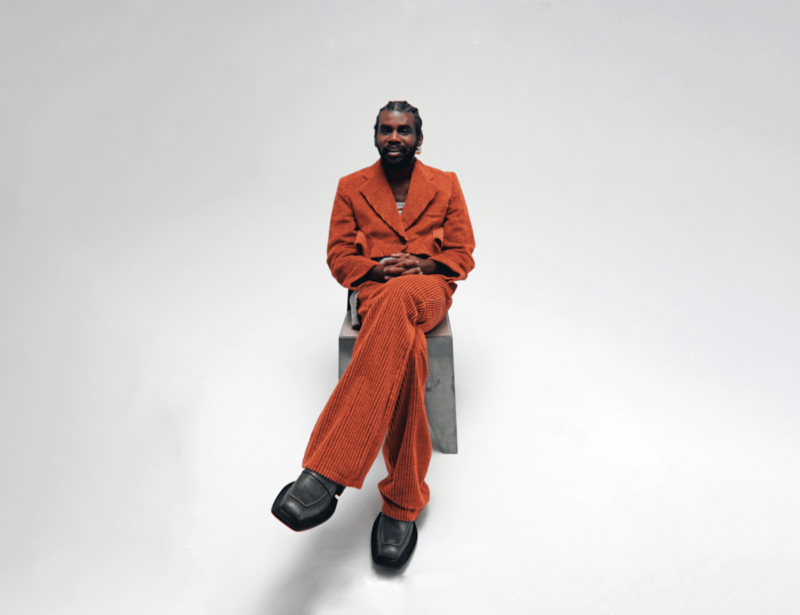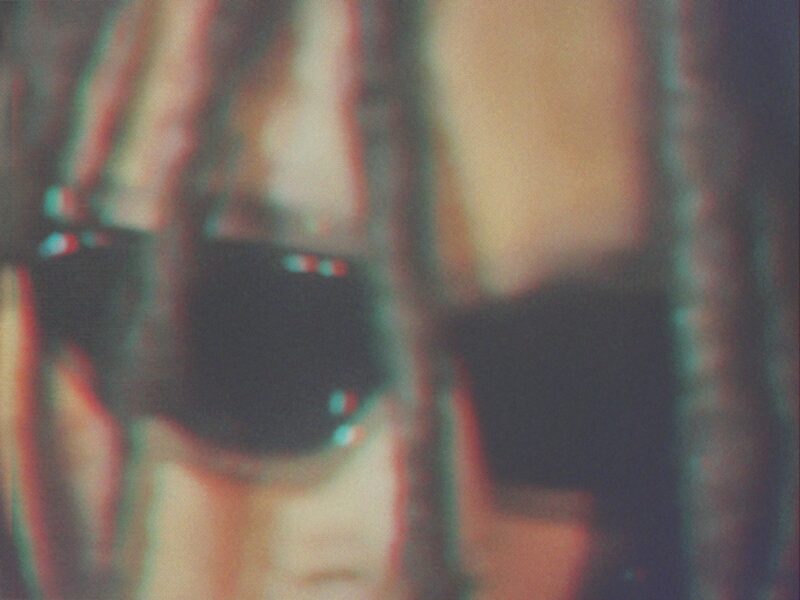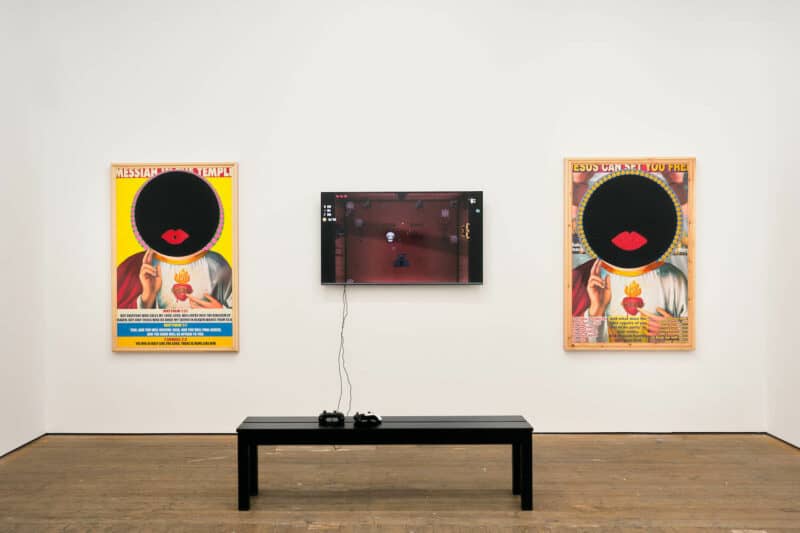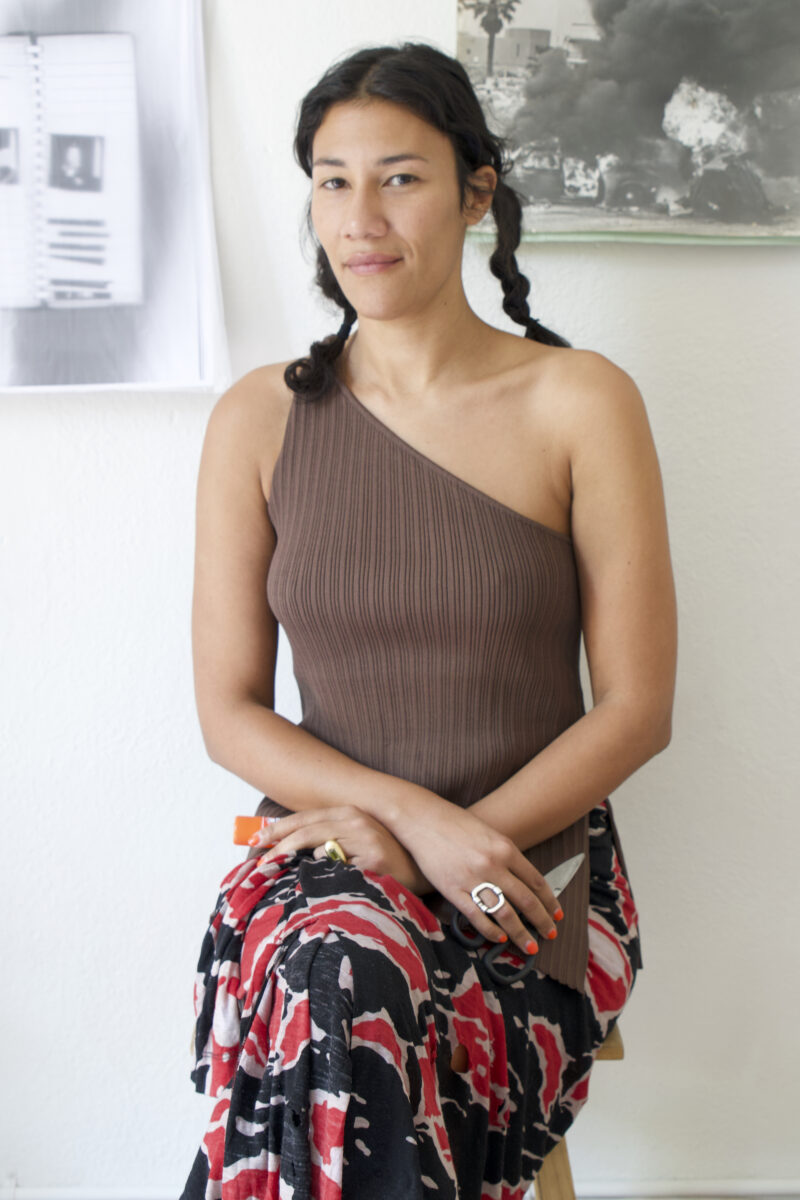
Lotte Andersen excavates histories and builds worlds based on community, connection, and memories. Andersen is a visual artist born and raised in London and currently living and working between Mexico City and Lima. She is known for utilizing musical engagements, histories of migration, and cultural artifacts.
Andersen uses imagery of friends, family, and found images to create rich thematic environments that transfigure a 2D plane. The sculptures, collages, videos, sounds, and performances are an extension not only of Andersen’s mixed-media talent but of her personality as well. The works created are from various worlds and confront fantastical scenarios while delving into a multitude of carefully articulated emotions and feelings.
The depth of Andersen’s work brings the viewer in touch with the omnipresent connectivity of real life and our worlds unknown. Her work investigates moments of perceptual in-betweenness, binaries such as familiar/strange, real/artificial, and image/object. Andersen’s work utilizes diverse methods of inspiration to dig into themes of ecology, friendliness and intimacy, popular fantasy, and colonization.
From 2011 to 2016, Andersen organized and ran MAXILLA, a series of parties hosted in West London. The party was accompanied by a collage invitation with found images and handwritten text and can be seen as the beginning stages of Andersen’s early movement into collage and experiments with text, found images, and formation.
Andersen has exhibited work at La Casa Encendida, Madrid; Whitechapel Gallery, London; Hyundai Card Storage Foundation, Seoul, Korea; David Kordansky, Los Angeles; and most recently at Helena Anrather, New York.
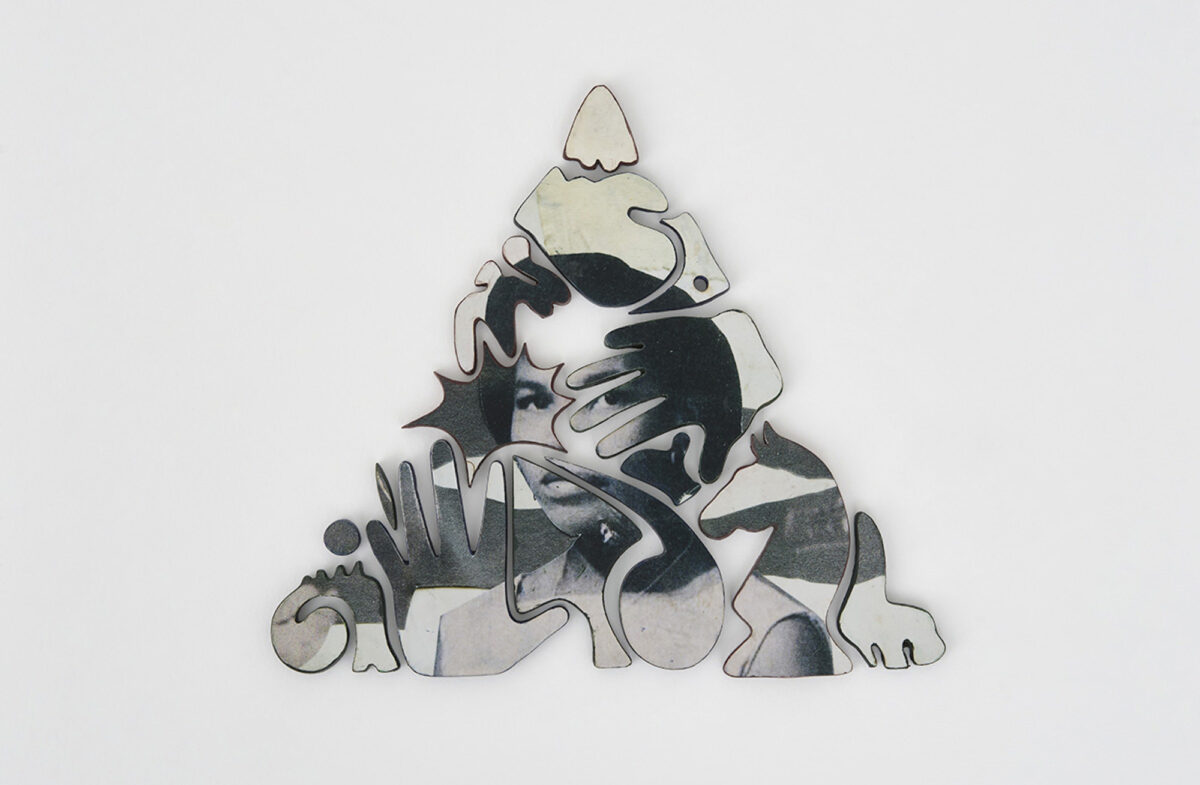
Phillip Edward Spradley: Can you talk about the genesis of your interests, and how these have developed further since leaving the United Kingdom? What do you think the landscape of Mexico and South America has given you and your way of working that you were unable to attain from being in London?

Lotte Andersen: I feel like my interests are a product of cultural clashes which presented themselves during my upbringing in London in the 90s…My father and sister are musicians, my aunt is a photographer and my grandparents are antique dealers, and on my mothers side music is central to the family dynamic. I was taken to museums, auction houses, galleries and nightclubs, which made my particular childhood. My mum banned tv, so I read a lot and got into sewing… later this led on to collaborating with them in an organic way. I also had the incredible fortune to study or work with interesting people like John Pearse or Tyrone Lebon or doing placements with Alexander Mcqueen and Tom Dixon. I always had an insatiable curiosity about people who made things, their internal drives and the scenes they existed in.
I moved to South America in 2019. I was upset about Brexit and the implications for the communities I existed in. It also signaled a shift in the politics of open borders and circulation. I found myself in Lima and subsequently adored and loved the rich Pre-Columbian history, visiting archeological sites and getting lost in the desert.
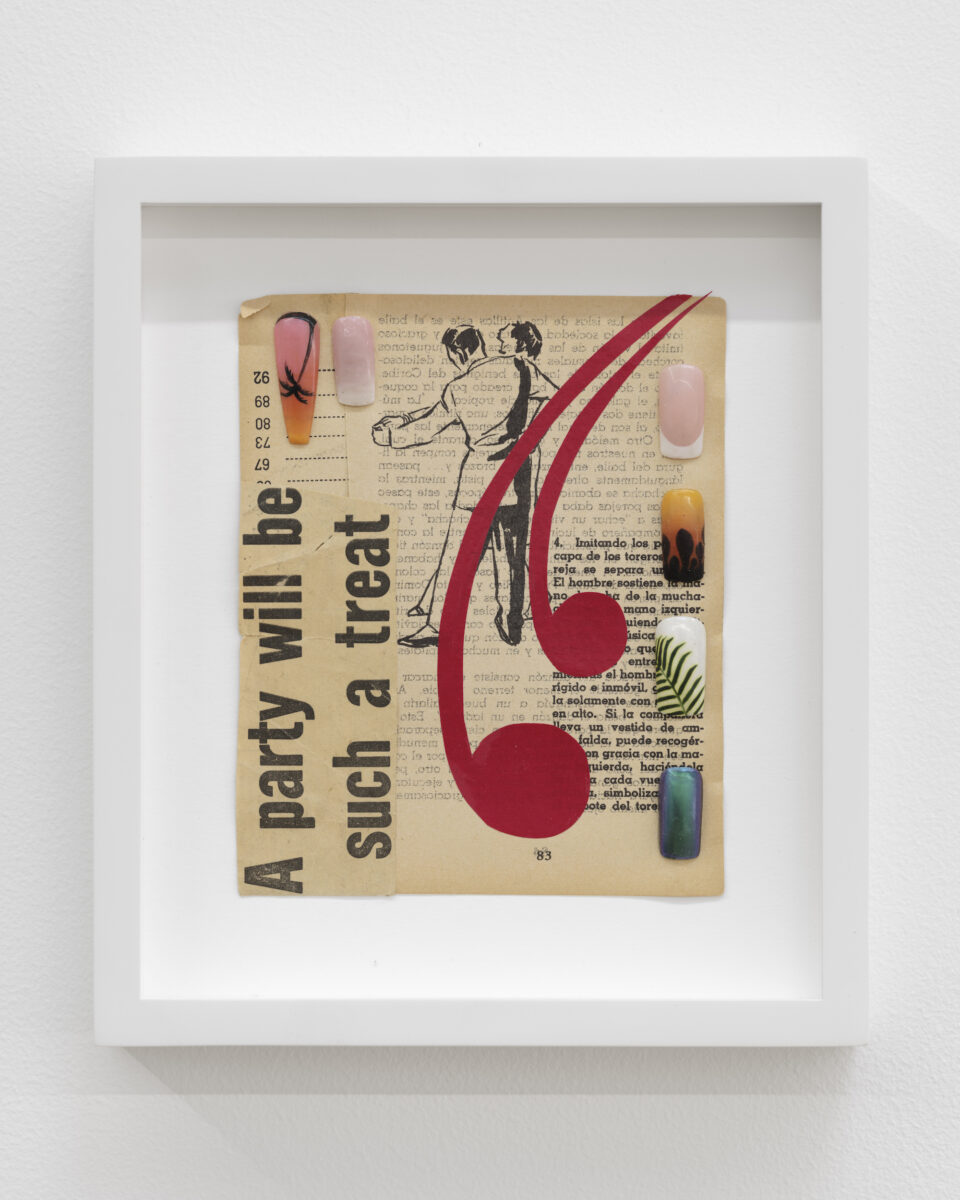
Moving to Mexico City expanded these feelings, particularly the ways these spaces have marked Western Art, and how those links have often been erased. A few weeks ago a Mexican curator and friend came over for lunch and we talked about how Pollock was a student of the painter David Alfaro Siqueiros; having attended his Experimental Workshop in New York – making the vital link between Mexican painting and abstract expressionism. I would love to spend some time in Brazil, where the Tropicalia movement emerged in the late 1960s; thinking about the symbiotic relationship between art, music and politics.
In London I found myself fascinated by events like Notting Hill Carnival, which was started by Caribbean immigrants, who brought soundsystem culture with them. In these ways I have found traveling alongside my work has provided more clarity to think about ideas of migration, rhythm and movement.
P.E.S.: In your most recent exhibition, Crowds and Crate Diggers, at Helena Anrather, you are gathering sound and waves of movement and placing it within a materialized object with weight and structure. What are some of the challenges you come across in communicating what has been described in music as energy, spirit, or even a vibe into a solid form that can be visually understood?
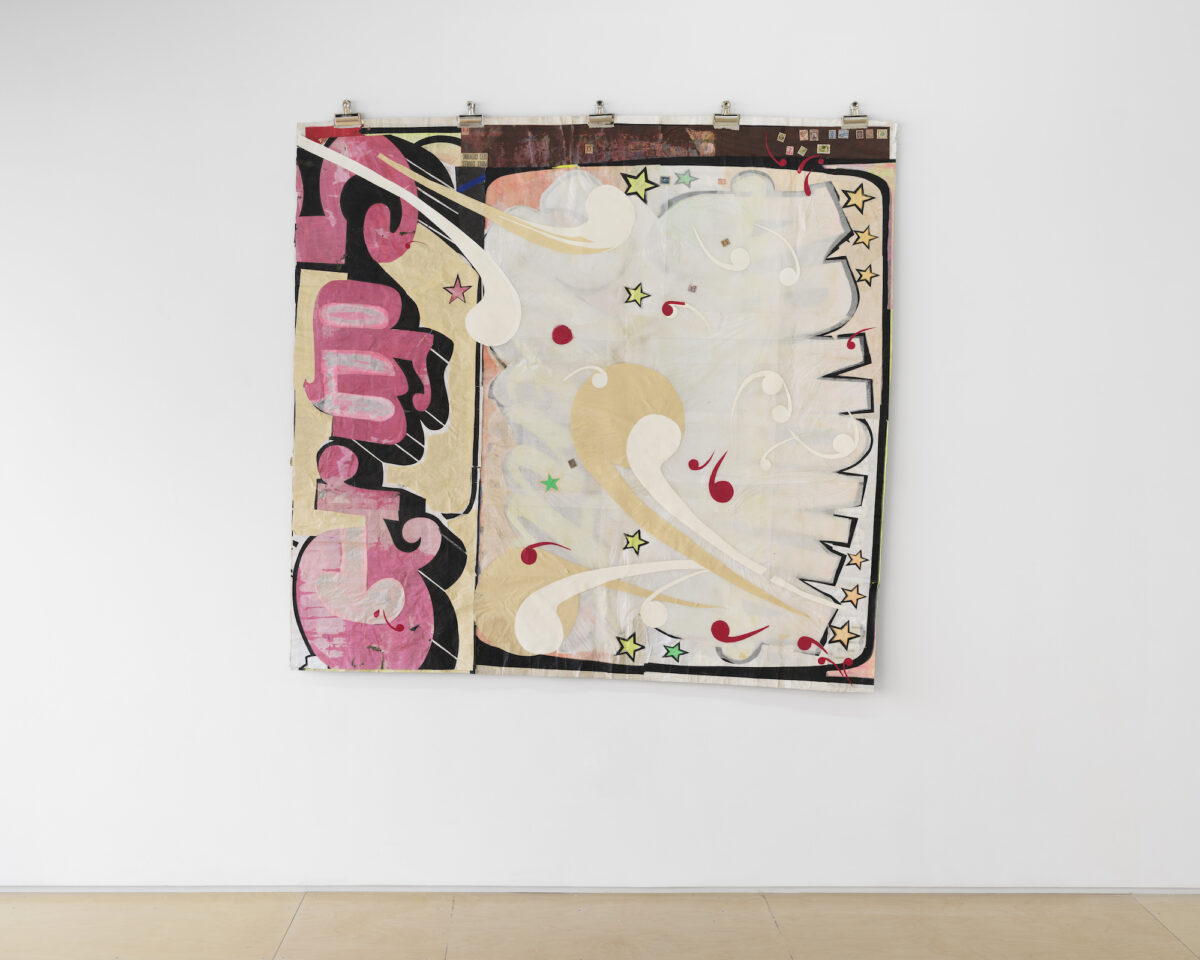
L.A.: Within my collage practice, I think carefully about the materials I use and their inherent historical value, along with their original purpose or function. In Gossip, the materials carry their own history of migration, sound and hybridity. The foundation of the work is a found Chicha poster, which I recovered in the north of Perú. I had begun collecting these posters, whilst living in Lima with my partner, searching and finding these giant paper artifacts, fallen off walls, once advertisements for Chicha parties. This musical genre emerged after families moved from the Andes or the Amazon to the urban capital, Lima. This hybrid musical genre materialized as part of a cultural production created by the children of these migrants, who were now living in an urban landscape-creating a vibrant and nuanced culture. The idea that rhythm and music is easily carried in transit, is prevalent within most histories of large scale migration all over the world. For instance the cajón, a percussion instrument present in Creole music, originates in west African traditions brought over during the colonial project in South America. Shipping crates, which contained tea or other goods, were often adapted into drums.
In its materiality Gossip, carries so much of the galvanizing quality of these moments of movement and celebration as well the socio-political history of a country in development. I have held a somewhat utopian belief through my expression, whether it was bringing people together to celebrate at MAXILLA, or later whilst making Dance therapy – that sound and group movement is valuable and serves to heal communities.Along the top right corner, stamps are embedded alongside musical notes, become speech marks, bouncing into commas, dancing across the surface, sprouting into the dreamlike space. Earlier this year I worked on a performance in the Museo de Arte Moderno in Mexico city, with Alonso Leon-Velarde and composer Max Manzano. We worked to adapt a deconstructed national anthem, written by Alonso and Naima Karlsson the year before, which I showed at David Kordansky. The anthem was performed by an 8 piece brass and percussion ensemble, inside the rotunda of the museum. At the time, I was working on Gossip in my studio and with hindsight I can see that the crescendo of cutout shapes which occupy the central space of the collage, carry the symbolic quality of Synthetic Opus being performed live. In this way I try to pull from life, and I try to take notice of the symphonic quality in the day to day.
P.E.S.: Capturing culture, an experience, an idea, in a tangible form is a great challenge, and you thoughtfully and successfully find the invisible, and the sometimes difficult to articulate, and make it physical. You are working from a deep well of rich histories, personal and communal, that foster cultural diplomacy. When investigating your interests that you wish to communicate further, do you have a base level or prepared method of research?
L.A.: The title Crowds and Crate Diggers for my show at Helena’s was an attempt to frame a certain element of my practice. Akin to Dj’s and music lovers, I sift through second hand books and look out for discarded paper artifacts. I enjoy working with found and archival materials like newspaper print, as they carry so much sensory pleasure for the crate digger. I love how ink fades over time, and becomes soft like tissue paper or dust patinas. Spending time in Perú was extraordinary from an archaeological perspective, as we could drive out to unmarked sites across the country and explore those kinds of landscapes. In the desert the sun bleaches everything out and leaves a layers of dust over everything…

My work, similar to an archivist is meditative, sifting through time and interacting with these different strands in time. Working as a tailor was also influential in thinking about how I cut out shapes, working with pattern masters and scissors with long blades. I can see pattern blocks within the shapes. I keep photographs and xeroxs in my studio sometimes for years, waiting for the right moment to use them. Will this be a puzzle? Will this be a collage? How do these need to be bound or stitched together?; metaphorically. I see photographs and news clippings like objects, similarly to how I think about sound. These things have a dimensionality, once you begin to consider their history and geopolitical context.
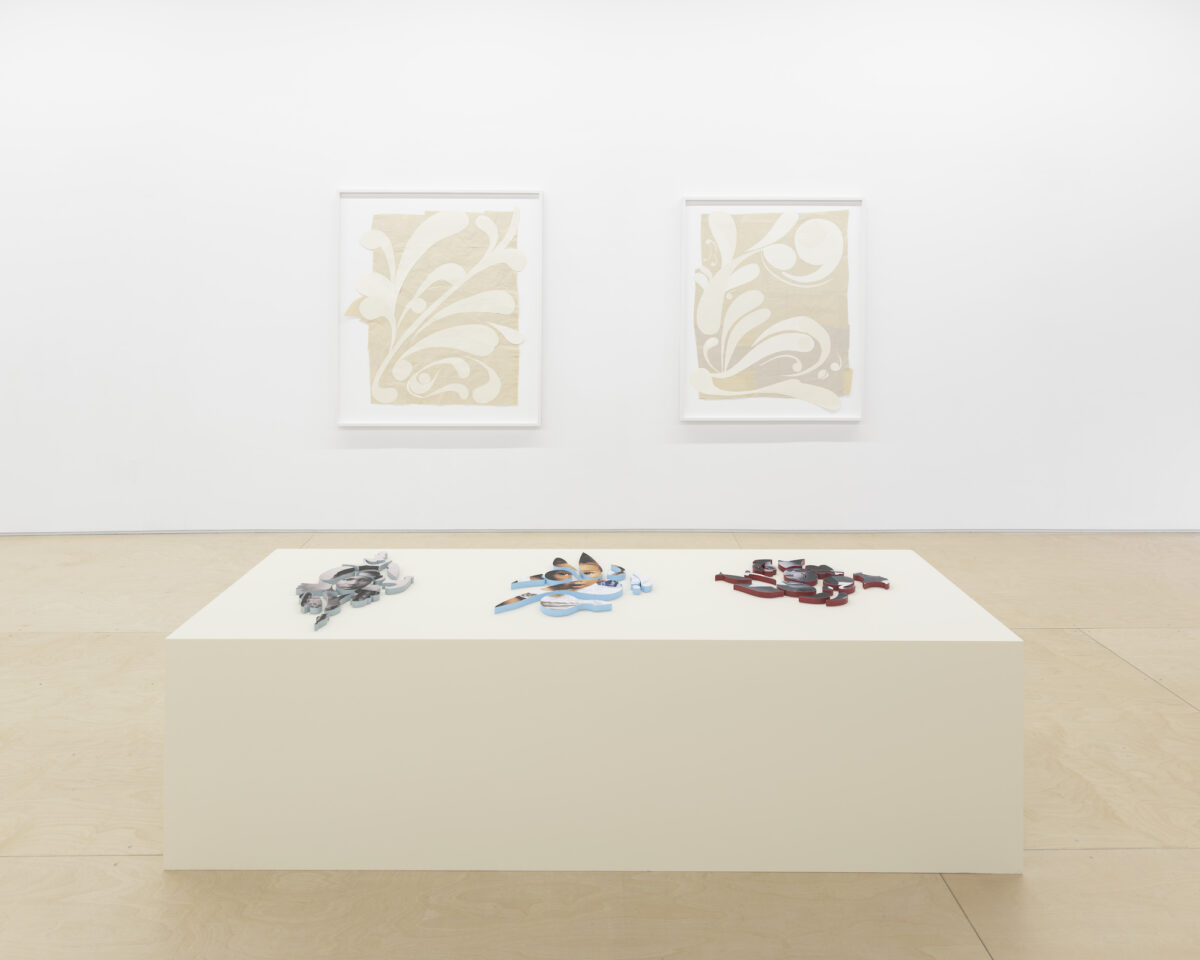
P.E.S.: What becomes popular culture starts off in dark, underground, intimate, and invitation-only spaces where people feel safe. I think about Black, queer, and punk cultures and how they provided new styles that are now highly celebrated, but once were not outwardly popularized by hierarchical sources. Your work provides an opportunity to develop and implement a bold vision of narrative that carries a legacy of creativity and experimentation through vibrant visuals, and to establish connections at local, national, and international levels. Can you discuss how you view your work as adding to the conversation of accessibility and engagement?

L.A.: When I began working I was interested in developing large scale video installations, I can remember feeling delighted that the sound would bleed all over the space. I am so interested in this quality that only sound can fulfill, in terms of echoic memory and how long the brain can store these. I often joke that a painting can’t live in your memory like three bars of a Dua Lipa song at 3am. Whilst I remain interested in the potential of video for activating the viewer, sometimes placing them within the work, many new preoccupations came up once I began to live in different places. I started to consider the speed of my work and the time the viewer has to engage with it.
I think Pop Music is the most important and one of the most versatile mediums of the 21st century. Musicians are like our gods and goddesses, we live out our fantasies through their vocal arrangements. In this way the club will always be a fertile landscape for artistic movements to emerge, alongside fashion and music. It is within this womblike, dimly lit space where we hang up ideologies and decompress. On the original soundtrack of Dance Therapy, I sample Adam F’s drum and bass track ‘Circles’- which was recently sampled by Pink Pantheress on her first single ‘Break it Off’. I think when you work sampling there are particular breaks or sounds which have a legacy in marking time and here the artist becomes a selector; digging it out at just the right time. Further into the soundtrack, I recorded a clip of Jarvis Cocker, the lead singer of the band Pulp, saying: ‘I think music’s natural habitat is the dark, most of life’s most pleasurable activities take place in the dark’.
In that way Dance Therapy is an artwork that I have grown with as it has traveled over the past 7 years. I showed the work in a photographic series at la Casa Encendida (Madrid), in a single channel presentation at Sheffield Docfest and on a 360 degree screen in The Hyundai Card foundation (Seoul). I enjoy if a work can collapse and take different forms, like the collages in relation to the puzzles, or even an anthem becoming a procession. In this way I hope my work creates all these different points of access; playing, listening, dancing, observing.
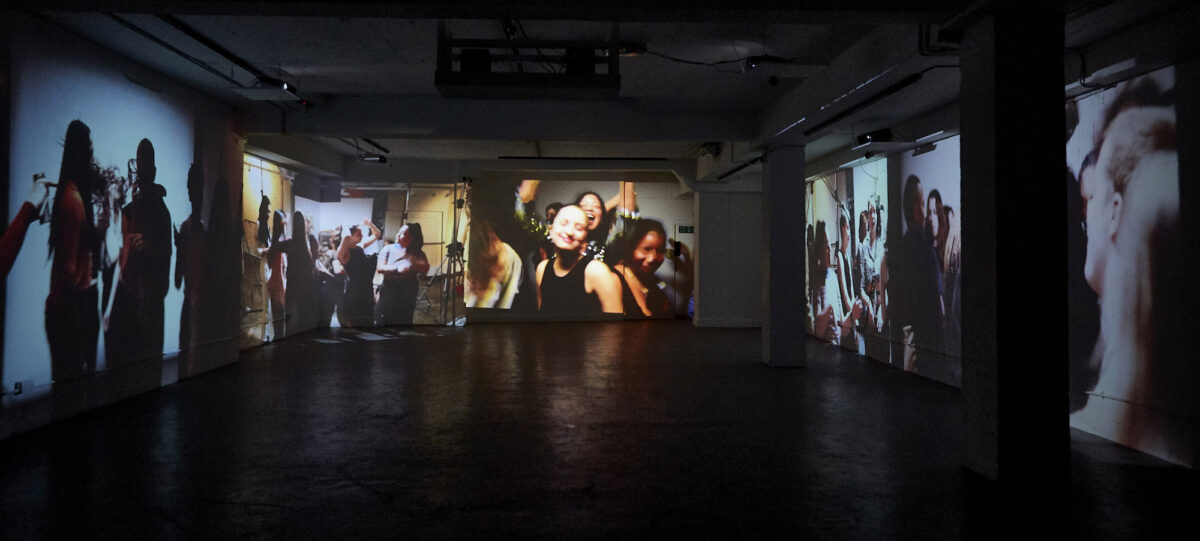
P.E.S.: Music, dancing, parties, and community require participation, as does experiencing art. I always think about a slight separation between a participant and an artwork, that being an initial understanding of what they are interacting with. Can you elaborate on how you view this divide and how this idea helps you navigate the space of arts institutions?
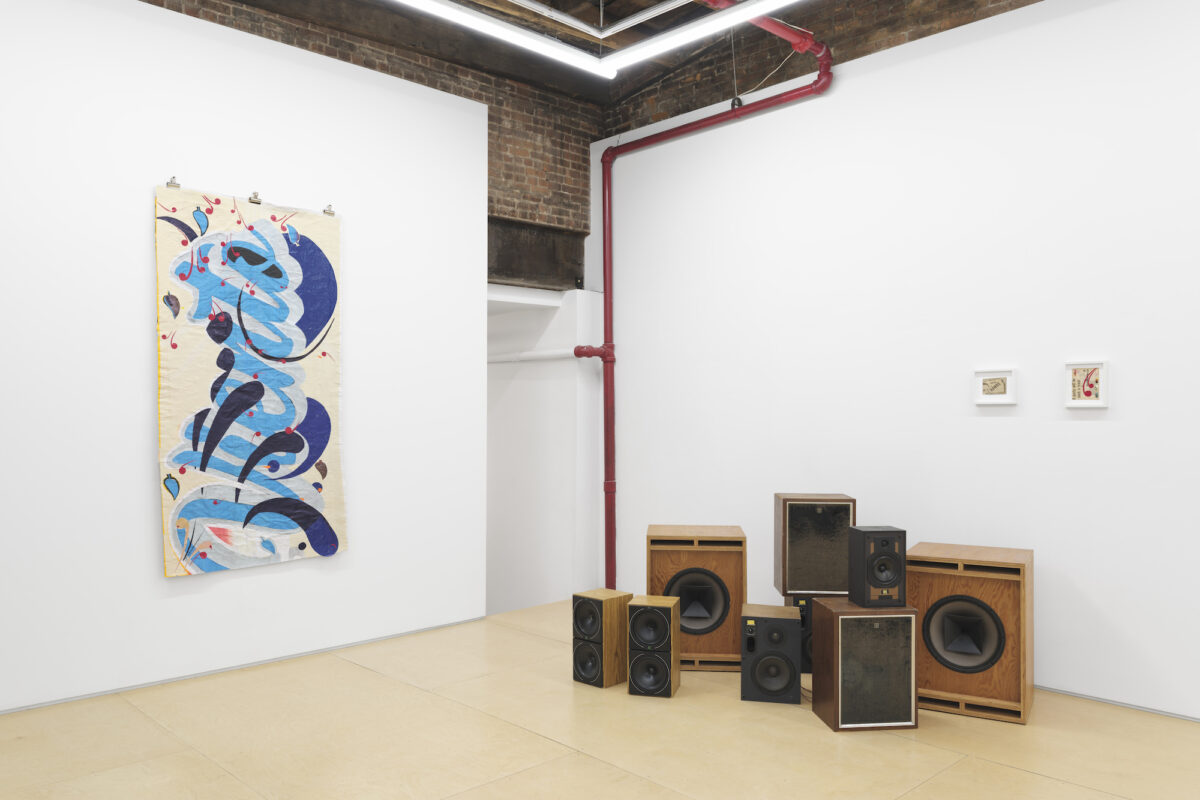
L.A.: I don’t see the participant as separate when interacting with my work. As my practice stemmed from communities gathering, I think there is an inherent social practice when it comes to the ways my work is programmed, which seems natural as my practice came out of social spaces. I also had the incredible opportunity to work in places which were built for social practice, like Yinka Shonibare’s Guest Projects or sound art programming like The Whitechapel Presents, where I organized a giant game of musical chairs.
The biggest challenge for my practice was Covid and the incorporation of health and safety restrictions into the gallery space. I had wanted to make a series of puzzles for a while, I was fascinated by the idea of a nuanced whole made of recognizable shapes and symbols. It felt natural to move the many insights I had gained dealing with groups of people into a more meditative and domestic setting.
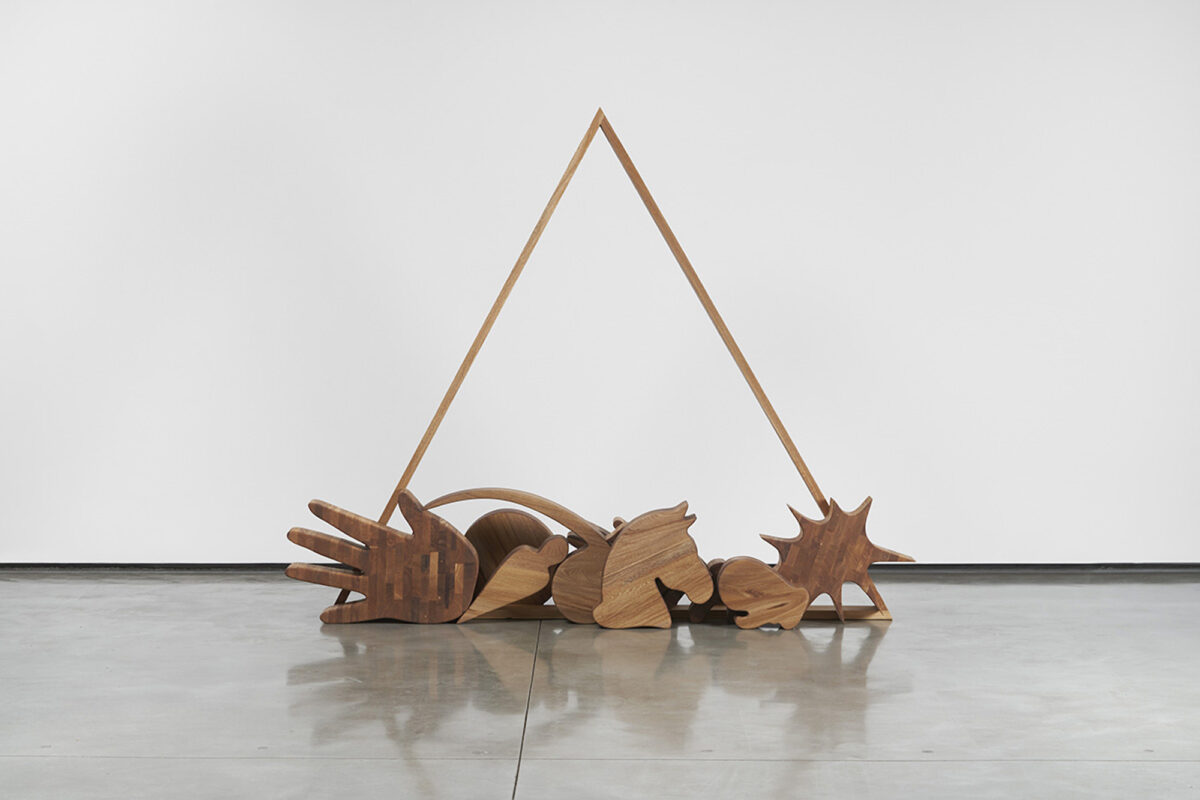
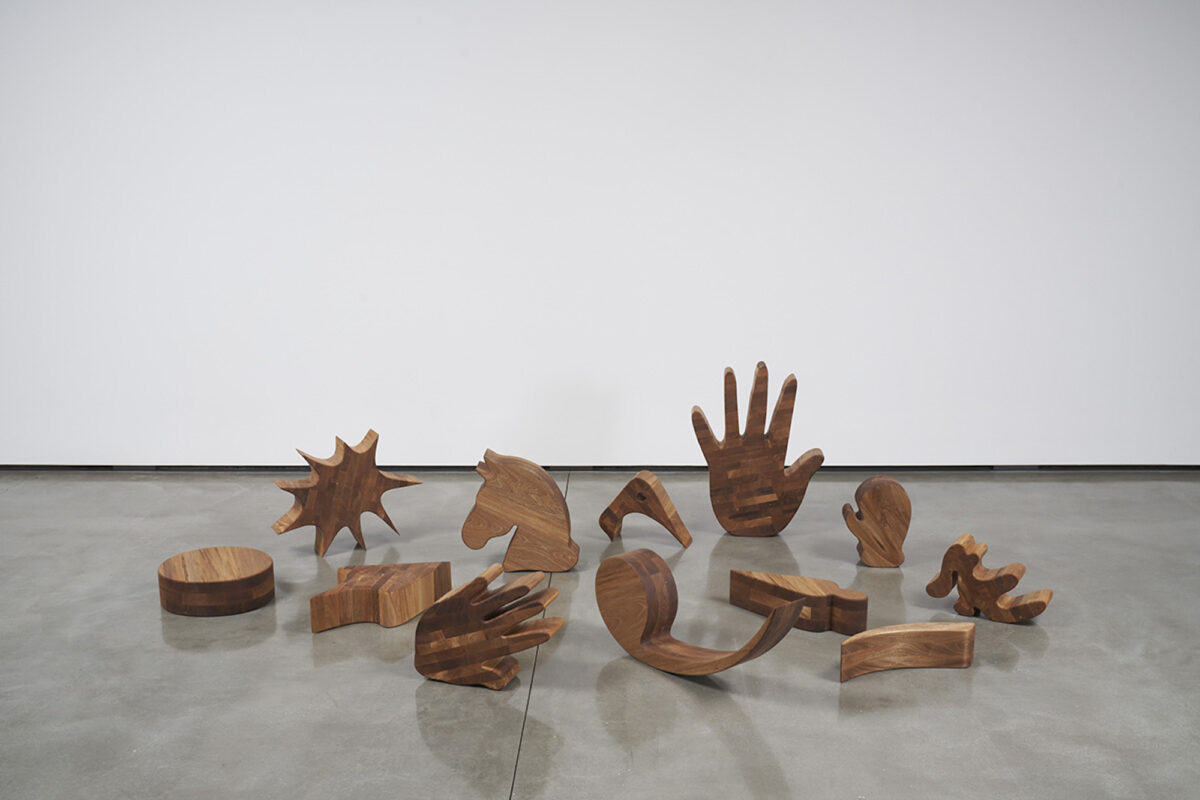
P.E.S.: You give agency to an audience to participate in your exhibitions: works such as Fortuna, nancy noo, and The Messenger, which are wooden collages presented in puzzle pieces, allow for alternate configuration. However, there is a unified form that allows participants to view a portrait of your family members. Can you discuss the cut-out shapes and the significance in those choices and the image? How do these patterns originate?

L.A.: The idea to make puzzles came from thinking of family constellations and the ways we each have our own unique perspective on events we experience is groups. I was invited to make a new series of works curated by Claudia Rankine’s research institute The Racial Imaginary at the start of 2022. Thinking through ideas of nationalism within interpersonal relationships, I narrowed a list of symbols; an arrow, a comma, a boxing glove, a bang, a knight chess piece. The symbols present in each puzzle serve to illustrate the scenes I present and have developed as the group of works has grown. Nancy noo, features a photograph of my younger sister by my aunt Emily Andersen, the shapes take the form of rattles, pacifiers and baby chews. The works have the option to be played with as puzzles and mounted into circular frames, reminiscent of Victorian cameos.
When I began to look into puzzles, I found that the first modern woodblock puzzles were made by the British cartographer John Spilbury, as an educational device called ‘dissected maps’. It felt important considering the themes to adopt this method of wooden pieces, with a unifying image. The decision to work with my family’s archive of images felt like a visual shorthand, perhaps a way to approach the feeling of being of mixed heritage. I thought a lot about Enzo Mari, in particular his animali puzzle, which felt like a turning point when thinking about the potential of the object.
P.E.S.: From where you were and where you are now in your praxis, what is something you then thought of as very important that you now find not as significant, or alternatively, something that once seemed insignificant that you now consider very important?
L.A.: I think growing up in London there is this constant rat race which I found very distracting, I was interested in building out spaces for culture to exist in. I think the huge turnover of clubs and social space into residential or commercial property affected subcultural scenes in the UK. I found that committing to living in other cultures where dance occurs in the streets has been revolutionary to me. That salsa exists as a container for community in a very quotidien and everyday way, is important.
To exist a little out of the way and yet still in the middle of an exploding art scene has led to many very significant friendships with artists. I find that there is a sense of helping each other out in how I live now, which is optimistic and generative. Also, having time to do nothing, to simply be in each other’s studios without interference. Additionally, it has been really interesting to put some space around different chapters in my life.
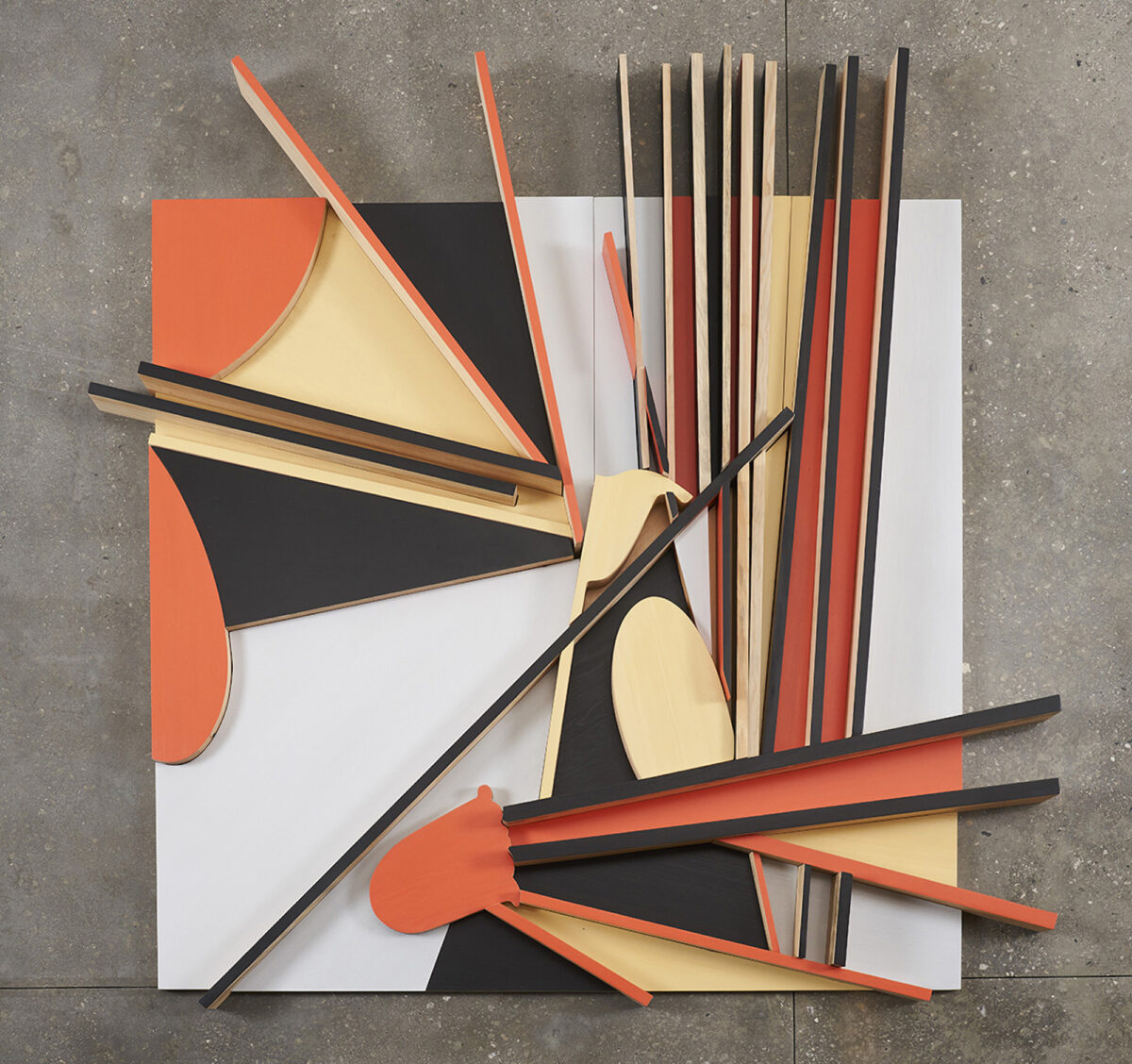
P.E.S.: What are some scenarios and ideas you have been fabricating that you would like to share?
L.A.: Last year I happened to live in a 1930s Mexican house, which was divided into a group of flats which had previously housed playwrights and other artists. At the time that my partner and I were living there, we shared space with a group of young artists. It was a really interesting experiment in living in a creative community. Additionally I have been working on a group of essays since 2019, which I am interested in compiling into a publication which features glimpses of this year amongst other printed works.
I will be showing two puzzles, and screening a video work at Gathering in London opening early December, as part of a group show curated by Lewis Dalton Gilbert. It will be the first time I am showing puzzles at home which is fun.

To learn more about Lotte Andersen, follow her on Instagram at @_lotte_andersen, visit her website at Lotte-Andersen.com, and see her work at Gathering, London in December 2023.


